Aug 20, 2019
Cable Maintenance
In last weeks article, (https://wisconsinpws.com/boat-lift-cable/) we discussed why your boat lift cable would not last forever.
This week we get into more detail and explain what you can do. We discuss the most critical causes of cable problems and what you can do to protect them.
There are two types of cable material used for boat lifts:
- Galvanized; and
- Stainless steel.
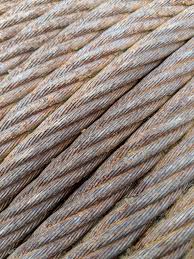
Rust on galvanized cable
Galvanized Steel is made of carbon steel which on its own is not resistant to rust. It is made corrosion resistant by running the cable through a hot bath of molten zinc. As long as the coating is on the wire “fibers,” it will resist the formation of rust.
Stainless Steel is also made of carbon steel. However, when mixed with about 10% chromium, it will form a stainless steel cable. It resists oxidation or corrosion. The chromium in the steel forms a layer of chromium oxide that promotes resistance to corrosion.
When the stainless steel wire is exposed to oxygen, the protective coating will REGENERATE. The anti-corrosion protection of the chromium maintains the resistance of the steel to rust.
Galvanized steel is less expensive than stainless steel due to the differences in the processing of each. Galvanized steel is durable, and each cable is sized to handle the loads created by your boat lift.
No – you can NOT increase the boat lift rating by merely increasing the size of the cable used. If you simply increase the diameter of the cable, you must also increase the size of the drum, or you risk early failure. The larger wire is stiffer and cannot bend around a smaller drum without damage.
Keep this information in mind if a neighbor or visitor wants to put their boat on your lift when it is empty. Know the weight of the new boat.
See https://wisconsinpws.com/boat-lift-calculations-part-4/ for additional information about cable maintenance.
Boat Positioning
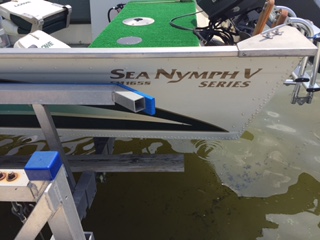
Boat stern overhanging too far
Make sure your boat is positioned correctly on the lift. If it’s not far enough forward, it will put excessive weight on the rear cables and the frame structure. On the other hand, if the boat is too far forward, you may damage the lower motor assembly or break the front cables due to excess weight.
In general, a boat has most of its weight at the stern where the motor is. As a result, to maintain proper balance on your lift, the boat stern should be about 6″ to12″ from the lift rack. See the above article for more information.
When properly balanced, the weight is evenly distributed across the lift rack. A balanced boat prevents overloading one end of the lift.
Note – unusually long boats, may be an exception to the 6-12″ rule. You must be especially careful to find the proper balance. Proper balance will minimize potential damage to the cables.
To summarize, take care of your cables, and they will last for years.
What Cable Maintenance Can I do by myself?
1. Make a visual inspection of the cables regularly. It is helpful to do this when the lift rack is in its lowest position to expose more cable. Look for chafing, corrosion or a flat cable especially near the winch box.
Don’t forget – do this inspection with leather gloves on to protect your hands.
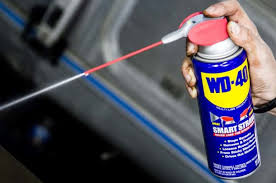
Boat Lift Cable Lubricant
2. At the beginning of the boating season, be sure to apply a burst of penetrating oil to the top of the cables around the winch drum. The penetrating oil will work its way down the wires as needed. Raise the rack halfway up and carefully apply another burst of penetrating oil to the winch drum. NEVER use grease on the cables. It traps moisture inside the strands. Do not be afraid to do it more often during the summer months, if you use the boatlift frequently.
Most quality lifts use Stainless Steel cables for a majority of cables and (1) galvanized cable as the main winch cable.
3. Watch the winch drum to ensure that the cable is wrapping smoothly on the drum.
Stainless steel lift cables also benefit from penetrating oil. We recommend this procedure in Spring, halfway through the boating season and again in Fall after removal.
To summarize, take care of your cables, and they may last for years. Remember, the cables and the winch do all the “work” on your lift. They do the lifting by raising the rack assembly with the weight of the watercraft on it. That’s a lot of weight so the cables must be well maintained.
In Conclusion
In Spring and Fall (and at least once during the summer months), put a short blast or two of PENETRATING oil on the cables wrapped around the winch drum from the top of the winch. Do not soak the wire until it drips when in the water. You don’t want to contaminate the water. Use only penetrating oil as the lubricant.
NEVER use grease (it traps the moisture inside the cable accelerating its deterioration).
Cable maintenance begins with inspecting cables for frays and rust – Caution – wear leather gloves to prevent injury to your hands. Check near the top of the winch cable as this is the most common area for frays. Replace as needed, if corrosion is present.
Check the alignment of all cables on the pulleys. Simply follow the cables down until they wrap around a pulley. Are they On a pulley or is the cable off to one side? Call PWS if they are.
With your watercraft on the rack – check for any slack in the cables. All cables should be equal in tension. Contact PWS for adjustment, if needed.
Look for cable corrosion near the winch with the rack fully down (but without slack in the lifting cables.
Remember, the cables and the winch do all the “work” on your lift. They do the lifting by raising the rack assembly with the weight of the watercraft on it. That’s a lot of weight so the cables must be well maintained.
Remember
Pier & Waterfront Solutions (PWS) specializes in all ShoreMaster docks, lifts, and accessories.
We are located in the center of Door County at 7325 St Hwy 57, just south of Sturgeon Bay at the intersection with Idlewild Road. Our staff looks forward to serving all of your waterfront needs.
Call Jerry at 920-493-4404 or Email Jerry@wisconsinpws.com for more information.
Aug 13, 2019
NOTHING LASTS FOREVER – EVEN A LIFT CABLE
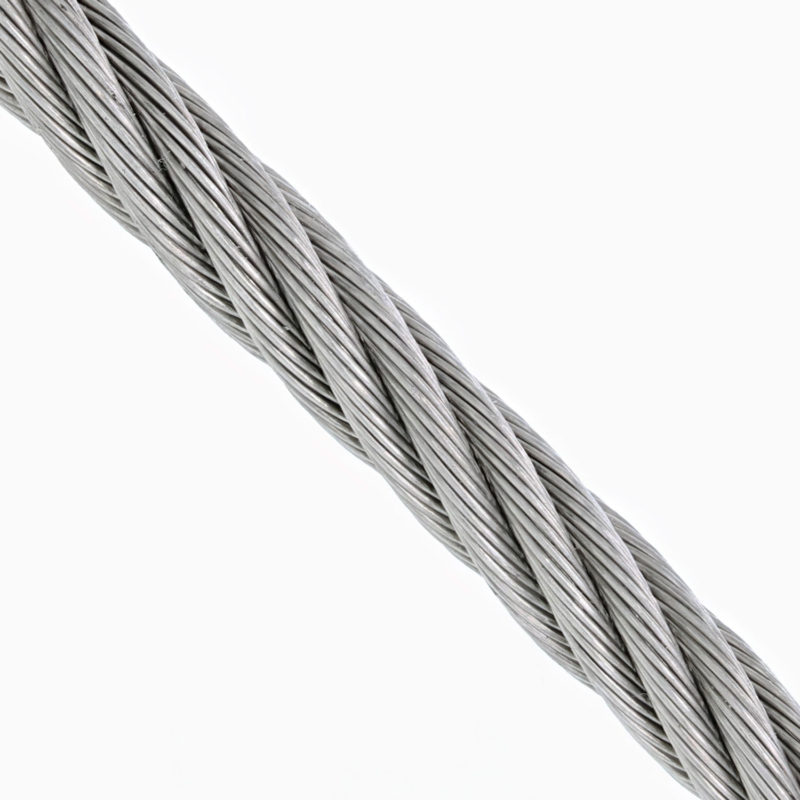
Typical Lift cable
That’s true! Your cables will eventually need replacement. When? That depends on you. If you’ve been around boat lifts for any length of time you have seen problems with boat lifts. Typical problems include corrosion, chafe, broken strands or kinks on the cables..
Let’s start by looking at the typical construction of a lift cable.
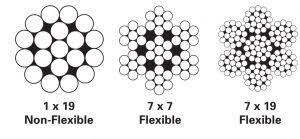
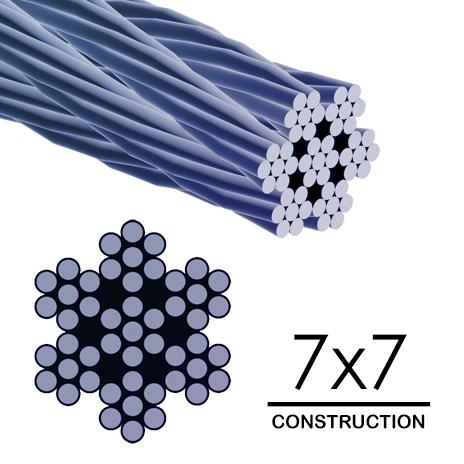
7 x 7 cable construction
The most common types are the 7 x 7 and 7 x 19 construction. As you can see they are not simply a wire hanging down that lifts your boat up. They are more complex than that.
The individual strands are wrapped together as shown Then they are wrapped again around a core.
HOW DO CABLES GET DAMAGED?
There are two types of wear:
External abrasion
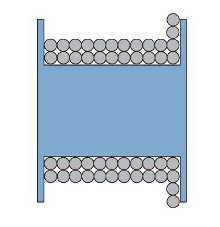
Typical Cable Stacking
This occurs when the cable bends around the winch drum and lift pulleys. On the winch drum, they rub against the adjoining wire or the drum sides. This rubbing causes wear on the external strands which will eventually wear through the individual stands.
If the cable doesn’t wrap properly, it starts to stack on the side of the winch drum. When the cable eventually slips off the “stack”, even though it is only dropping 1/4″ to 1/2″, the resulting noise shocks anyone nearby. It was under hundreds of pounds of pressure from the boat. This situation is usually caused by misalignment of the winch drum or a poorly threaded situation.
New ShoreMaster winches are attached with a complete housing around the upright post which prevents this from happening due to winch misalignment. More on this later in this discussion.
Internal abrasion
Internal abrasion occurs whenever strands work against each other under load. Each time a boat is raised or lowered over a winch drum, there is internal wear. Each strand of wire in the winding is moving at a slightly different speed. Abrasion of the strands is the result. When you lose too many strands, you lose a lot of strength. This condition cannot be eliminated but it can be controlled by using the proper size winch drum and pulleys.
A point often overlooked – internal abrasion and the resulting corrosion or rust in a galvanized cable, can be hidden and may not show visible damage. A cable like this may sometimes fail without prior warning.
ASSUMING IT IS WELL CARED FOR, HOW LONG SHOULD IT LAST?
Experts say that to be safe, replace a galvanized cable every two years. All things being equal, stainless wires will last longer-up to twice as long. But don’t rush out and try to change all your cables to stainless. Galvanized cable has its place on your lift. For one, they are stronger than stainless steel and can bend easier around the pulley and winch drum.
An improperly positioned boat may send your boat into the water. See https://wisconsinpws.com/boat-lift-safety-updated/ for more information.
When in doubt, replace the cable. Trying to squeeze another year out of the cable isn’t worth the risk of dropping your boat or personal injury.
COMMON PROBLEMS WITH BOAT LIFT CABLES
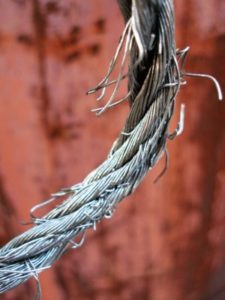
Frayed Boat Lift Cable
Chafe or fraying – are those fine broken strands that poke or cut your hands when you slide your hands along the cable. If you catch your clothes when they brush against a cable you have “chafe” or fraying.
Chafe may be the result of faulty sheave alignment or improper drum winding.
Lowering a lift rack without any weight on it, especially on a small lift like a PWC lift, may also result in a “backlash.” This is discussed later.
Note: Be aware that most winches require at least 50 lbs of weight to work correctly.
BROKEN STRANDS

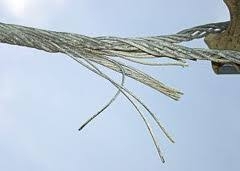
Broken Strands
Broken strands are very dangerous. Boat lifts with this type of damage should be replaced immediately.
CORROSION
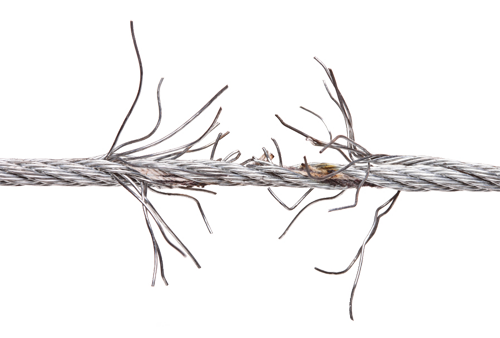
Corroded & Frayed Boat lift Cable
Corrosion presents a significant problem for galvanized cables. When the protective layer of galvanizing wears through as discussed above, corrosion will begin. Corrosion may not always be visible to the naked eye. The first time you become aware of the corrosion could be when the cable breaks.
Corrosion may also occur “inside” the cable with little or no external evidence of the damage as discussed above. Any cable showing external signs of rust or corrosion needs replacement.
BACKLASH
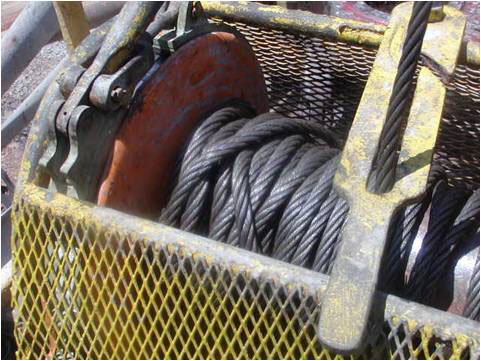
Boat lift cable backlash
When a lift is lowered to the bottom and the winch continues to move the result will be a Backlash. If there is insufficient tension on the cables they will “spring” in every direction on the winch drum. When you retighten the cable, the loose cables become snarled and can wrap up like a backlash in a fishing reel.
WHAT IF I EXPERIENCE A BACKLASH?
Whenever a cable experiences a backlash DO NOT use your bare hands to repair the problem (chafe). You won’t soon forget this if it happens to you. People have also lost fingers when a cable snaps back onto a winch drum. Make sure you wear leather gloves and keep tension on the cable at all times. Keep your hand at least 12″ from the winch to prevent entanglement.
When you experience a backlash, lower the boat into the water to prevent the cables from interleaving further on the drum.
Never use bare fingers or pliers to align the cables. As always, carefully handle it to avoid breakage of the wire strands.
Next, unwind the winch while keeping tension on it. Do this until you see the bottom layer on the drum. Re-wrap the cable onto the winch drum while maintaining tension. Rewind it in even layers. Be sure to close any gaps between the cable on the winch drum.
Finally, it is time to return your boat to the lift to raise it, making sure the cable continues to wind smoothly. If the problem persists, call your lift dealer (that’s PWS)
DID YOU REMEMBER THE WIRE “MEMORY”?
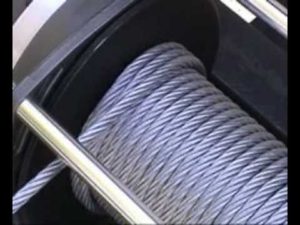
Properly wound cable
“Memory” allows the cable to play out and rewind onto the drum in a neat pattern. The wire must wind in a set pattern. Loose that “memory” and misalignment occurs which will cause the cable to turn against the side of the winch drum.
Maintain tension at all times to prevent the cable from interleafing with the windings in a lower layer. Fill in each layer completely, leaving no gaps.
WHAT’S COMING UP NEXT WEEK?
Next week we give you more information about boat lift cables and what you can do to lengthen their life.
Remember
Pier & Waterfront Solutions (PWS) specializes in all ShoreMaster docks, lifts, and accessories.
We are located in the center of Door County at 7325 St Hwy 57, just south of Sturgeon Bay at the intersection with Idlewild Road. Our staff looks forward to serving all of your waterfront needs.
Call Jerry at 920-493-4404 or Email Jerry@wisconsinpws.com for more information.
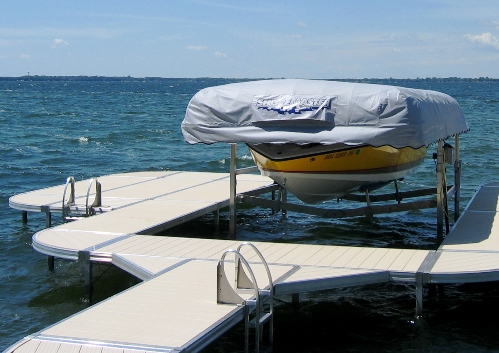
Jul 30, 2019
BOAT LIFT SELECTION
Purchasing a boat lift (new or used) can be very confusing. There is a lot to consider before making your selection. This article will assist you in making the right decision.
Let’s start with, where will you be using the boat lift?
Why is location important? The location will be an essential consideration for determining the suitability of a boat lift for the body of water you are on. Will you be on the Bay of Green Bay, Lake Winnebago, a river or a small inland lake?
On larger bodies of water, vertical boat lifts are the preferred choice. Why? The answer is the extra lifting height you get versus a cantilever lift.

2019 Storm Challenges
2019 is proving to be a challenging year for most dock and boat lift owners. With record-setting water depths and strong, frequent storms, owners see the need for the higher lifting capacities.
Unlike people on small lakes, the Bay of Green Bay and Lake Winnebago present unique problems for boaters. The reasons are the storm surges. A storm surge is caused by sustained winds blowing in one direction with no rivers or creeks on the leeward side to relieve the pressure of the water piling up. Wave action of 4 or more feet on top of a water surge makes the situation even worse.
These two factors combined, mean you will need a lift that raises high enough to keep your investment from being damaged. You also need the most durable frame construction possible.
Frame strength is achieved by using a more substantial square or rectangular frame versus a round, thin tube. If the frame is not strong enough, you won’t get the extra protection your boat deserves. That’s why PWS only handles ShoreMaster boat lifts.
Rivers have unique problems in the form of fluctuations in water depth in early spring from snow melting and heavy rain runoff during the season. Any boat lift must be capable of handling the changing water levels here too.
Depth of water is another consideration.
Vertical lifts, with a “V” rack, require about 6″ of water plus the draft of the boat to operate. This low water requirement is vital if the water recedes in late summer or fall.
Boat length, width, and weight affect your choice.
PWS recommends that you consider not only the length, width, and weight of the boat you currently have, but also the possibility of a larger boat in the future. It will save you money in the long run. People frequently change to a bigger, better boat, so you should not ignore this issue.
Why do we insist on checking the weight you give us for your boat?
It’s not that we don’t trust you – we simply don’t trust you, but in a good way. Our reputation is on the line with every lift we sell, so it has to be the right one for your needs. Some salespeople quickly choose the lift you “need” without even looking up the Specifications to be sure. Remember, the weight is more than the boat weight.
See also https://wisconsinpws.com/boat-lift-calculations-part-4/
Will you raise the boat by hand or do you need a motor?
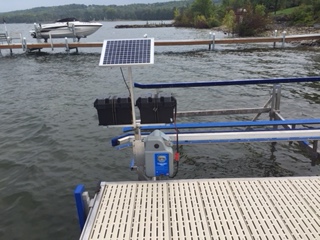
24 V Solar Panel arrangement
Do you want to raise your boat with the winch wheel or use a remote-controlled motor to do the work for you? 12V/24V D.C. motors power most boat lifts with 120V A.C. used less frequently.
Nature charges your battery via a solar panel, and there is no cost to do it.
A.C. versions, while available, require 120 V power at the boat site and require more care to prevent electrical shock.
What are the Frame Materials?

Corroded & Frayed Boatlift Cable
The most popular boat lifts in N.E. Wisconsin have aluminum frames and stainless steel cables.
There are still a few steel boat lifts around.
But they are few and far between due to their weight, limited lifting heights and susceptibility to rust.
Aluminum boat lifts will have either galvanized or stainless steel cables. Sometimes they have a combination of both materials. Stainless steel cables last as much as 2-4 times longer than galvanized steel cables and don’t rust.
What about the pulleys on the lift?
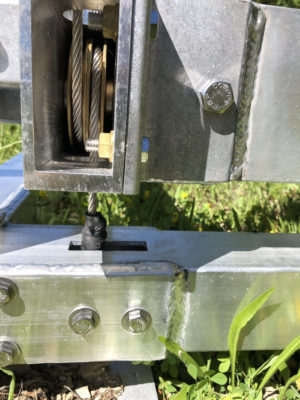
ShoreMaster Brass Pulleys
Pulleys on boat lifts will be either plastic, steel or brass construction. Robust brass pulleys with stainless steel hubs are
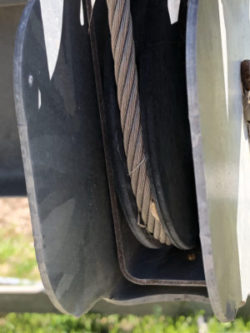
Plastic Pulleys
the best choice while plastic pulleys are not recommended even on the lighter PWC lifts. The heavier the boat, the more critical it is to have stainless steel and brass materials.
Plastic pulleys become brittle over time. Eventually, the edges break off, and the cable gets jammed between the frame and the pulley. Raising a boat with a jammed cable is extremely hard to do.
Who will install the boat lift?
A professional company is best suited to do this for you.
Boat lifts in the 5000# range or larger, definitely require professional installation and removal services. It’s not a job for amateurs. Do you have a dependable provider for this service? PWS has experienced, trained people and the necessary equipment to do it for you,
What is the Warranty?
Many boat lifts come with a 1 or 2-year factory structural warranty. Some have five-year, and a few even have a 10-year warranty. ShoreMaster boat lifts carry a full 15-year structural warranty. The 15-year warranty is the best on the market.
SEE https://shoremasteravala.blob.core.windows.net/media/1588/shoremaster-warranty-12142016.pdf
Now it’s up to you! Our recommendation? See what your neighbors have to say about PWS.

Customer Testimonials
Do you have a friend that might be interested in this post? Please forward it to them.
Pier & Waterfront Solutions
PWS is located at 7325 St. Hwy 57. That’s 1 mile North of County MM (Hwy 42) and 3 miles south of Sturgeon Bay at the Idlewild Road intersection. Or – for more information, you can call Jerry @ 920-493-4404.
Apr 30, 2019
INSURANCE FOR YOUR BOAT LIFT

Insurance Forms
With insurance, you expect EVERYTHING you own to be covered for damages. Even your dock and boat lift. But is that the case?
Here in Wisconsin, if you own a dock or boat lift, you have made a sizable investment. Of course, you want to make sure that they are insured. We urge you to make sure that all of your water equipment is protected. Insurance can be complicated, so you do need to talk to your agent. Make sure they research all scenarios.
Let’s discuss the various situations you may encounter.
Boat Insurance
Boat insurance is no different than auto insurance. But what exactly does the boat insurance cover? Boat lifts are not generally covered under a dock or boat policy. Boat insurance only covers the vessel itself. Think about it – your garage is not covered under your auto policy. Why would your boat, dock or lift be any different? Typically you have to have a rider to ensure your dock or lift.
Homeowners Insurance
Most homeowners believe that their dock and boat lift are part of their property. They think their homeowners’ insurance should cover them. Unfortunately, that’s usually not the case. Your dock may or may not be covered by your homeowners’ insurance.. Be sure to ask about it. Is your agent aware of it’s value?.
Liability insurance
It’s vital that you have not only physical damage but also liability insurance for your dock. Docks can be dangerous, and you’ll want to make sure you’re covered if someone were to get hurt on your dock. As for the physical damage coverage, make sure you understand what circumstances are covered, wind, fire, and snow all need to be considered.
Some Questions to ask your Insurance agent
Do you need:
Storage Insurance – Just like renters insurance you should consider storage insurance when your boat is not in use. Storage insurance can provide another layer of protection. The good news is there is less risk of liability while your boat is in storage. The insured premiums usually are reduced during that period.
Comprehensive coverage – This usually covers theft, accidental loss, or damage.
Replacement Costs – If you want to replace your boat after an accident, you will need to have coverage that is close to the current market value of your boat. You can adjust it to account for depreciation at each renewal.
Trailer Coverage – If you have a boat, you probably have a trailer to transport it around. Do you have coverage for your trailer and it’s cargo while being moved?
Accessory Equipment – Does your insurance cover your navigational equipment, lighting, and stereo systems and the other “toys” you added to the boat over time.
Mileage Restrictions – Does your policy restrict your mileage from where your boat is stored and used? Which insurance covers the boat while being transported to and from the storage unit?
Salvage insurance – What policy pays if your boat sinks after an accident or if you forget to replace the drain plug?
DOES YOUR INSURANCE POLICY COVER:
Geographic Limitations – Your insurance policy may have specific physical or bodies of water limitations. Going to take your boat around the country? You may need a plan that will cover it under those circumstances.
Good news: Your dock or boat lift, while stored on your residence premises (not necessarily in the water) would be covered by a standard Homeowners policy. It should be handled under a structure or as personal property. It will, however, be subject to the policy deductible. However, there may be other considerations.
WAVE DAMAGE – Damage to your lift or dock is NOT going to be covered if it is the result of waves. Even if the water is driven by the wind, it probably won’t be included. If wind-driven waves knock your dock or boat lift over, you will be responsible for damages. An exception might be if the waves caused a log, another dock or a boat to strike your equipment. The problem is, you have to prove it. If you see this situation happening your best option is to take photos. Better yet, a video of it happening might increase your chances of being covered. If the wind directly causes damage to the dock or lift, that loss should be covered by your insurance. Example, a dock accessory has blown off the dock by the wind, is probably covered under your policy.
WHAT ABOUT:
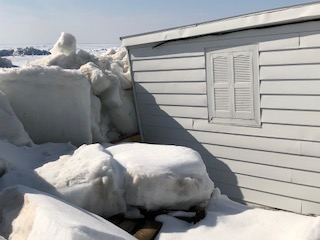
Ice Damage
ICE DAMAGE – Your dock or lift is not covered by damage caused by ice. If you leave your dock in the water over the winter and moving ice destroys it during the spring thaw, your Homeowners carrier is likely to deny that claim. Or if you leave your boat lift in the water and the pressure from freezing or thawing of the ice around it causes damage, again, this is most likely not covered. What if our dock is stored on your beachfront or lawn. If an ice shove occurs will it be covered? If your equipment is stored on your neighbors property and the ice gets to it, is it covered? Remember, it isn’t on your Resident Premises. See below for more information.
Beyond these circumstances, there are other circumstances where coverage could hinge on whether your dock or lift is considered a structure or personal property. This can matter because policy coverage provisions for structures and personal property are entirely different.
HOW IS YOUR DOCK DEFINED?
PERMANENT DOCK – If your dock or lift is permanently set in place and attached to its location, it is almost certainly a structure. But is it covered under your policy? The answer to this question may depend on which insurance company you ask. (This means you probably need to ask.)
PORTABLE DOCK – Most Wisconsin property owners remove their docks and lifts for the winter to protect them from ice damage. In that case, Is a movable structure still a structure? If your portable dock or boat lift is not considered a structure, then it should be regarded as personal property and typically covered against loss caused by one of the perils named in the policy. It includes fire, vandalism, and falling objects, among other damages. The other good news is that, as personal property, your dock or lift is covered anywhere in the world, even if it isn’t located where you live. Maybe.
What is the deductible?
However, the big question is – Is your dock or boat lift covered while in the water? You need to ask your agent.
DEFINE STRUCTURES
Things can get a bit more complicated if your dock or lift is considered a structure. First of all, most Homeowners policies only cover structures located on your “residence premises.” So if you own a dock or lift situated in a resort or on a vacant lake lot and it’s considered a structure, then you are going to need to add individual coverage for it. Many insurance companies offer an option to add coverage for structures located elsewhere.
Another problem – it may not be clear whether your dock or lift is on the “residence premises” or not. Perhaps you have a boat lift set up at a resort which you insure as a seasonal residence. If your policy includes coverage for Other Structures, will it cover your boat lift located elsewhere in the resort? Or what if you have a dock where you live, but your legal boundary stops just short of where it sits?
WHAT ARE “RESIDENT PREMISES”?
Standard homeowners policies define your “residenTpremises” as “including the structures and grounds at the location of your insured home.” .In the case of a dock at the edge of your land but just beyond your property’s legal boundaries, would it be considered at the same location as your home and therefore covered? In the case of the boat lift located across the resort from the lot you occupy, there may still be an argument to be made in favor of coverage. However, coverage seems less certain. Be careful, as some non-standard policies might define “residence premises” even more narrowly.
Insurance gets complicated, so my recommendation is to talk frankly to your agent. Talk about your winter and summer situation. Get a clear definition (preferably an opinion in writing, if it is not written in your policy. The definition is critical and may vary by the insurance company.
The information contained here includes a lot of “should be”‘s, “if’s,” “but”s, and “however”s. We are not insurance agents and opinions expressed here are just that – opinions. Now it’s up to you to get the conversations started with your agent.
PWS does Free quotes for insurance damages.
PWS is located at 7325 St. Hwy 57. That’s 1 mile North of County MM (Hwy 42) and 3 miles South of Sturgeon Bay at the Idlewild Road intersection. Our staff is here year-round to assist you.

Apr 2, 2019
Boat Lift Accessories
Boat lift accessories relieve a lot of stress and work. You don’t have to worry about the hull and motor getting fouled after sitting in the water for too long. Think of the time and work you’ll save by not having to put your boat back on the trailer every time you use it. It also relieves your stress during a storm.
Life is just better when you’ve got a boat lift with the right accessories to protect your boat. Accessories for your boat lift include things like solar systems and wireless remote controlled lift motors or a simple canopy.
Here’s a summary of the most popular boat lift accessories that we recommend for your lift:
Guide-Ons

Full-Length Guides
Guide-ons make it easier to get the boat on the lift and keep both the boat and lift from sustaining damage in the process.
They come in two basic configurations including:
Vertical PVC guide-ons which consist simply of vertical PVC or foam posts, often covered by fabric. As the name implies they guide boats to help you get your boat onto the lift correctly.
Much more popular are the full-length guide-on systems. Full-Length guide-ons consist of a pair of wood or aluminum guides that mount near the sides of the boat rack. They can adjust both horizontally and vertically for a perfect fit to your boat. They are a physical aid for centering and loading your boat onto the lift.
The guide-ons come carpeted or with a vinyl covering. Vinyl covered guides greatly reduce the maintenance of the guides and are preferred by most boaters.
Bow Guide/Stops
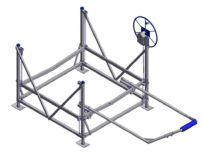
ShoreMaster Bow Guide Schematic
Bow Guide/Stops are a bow-shaped beam at the front of the lift. They keep you from overrunning the boat lift. They ensure proper positioning without effort. It prevents the boat from being pushed too far into the lift by the waves. A properly positioned boat helps reduce the strain on the cables by applying equal weight to all the cables. This is crucial to the life of the cables.
Pontoon bunks
Most Pontoon bunks come in two styles:
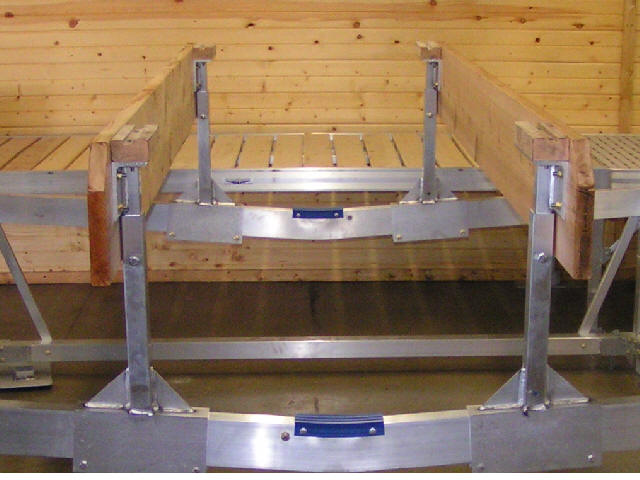
Pontoon deck support

Pontoon Tube Supports
As the names imply the tube supports sit under the tubes and the deck support is under the deck. Opinions differ on which one is better to use. It all comes down to personal choice.
Solar Panel Systems

24 V Solar Panel arrangement
Your boat lift may include various systems that run off of electricity. This includes the boat, a lift motor or lighting. We can set up a solar charging system to charge your boat battery as well
as an electric lift motor.
A solar system consists of a solar panel which can attach to the boat lift or battery box. The kit will charge either a battery in a battery tray, or directly charge the battery in your PWC personal watercraft or boat lift. We size the panels and batteries to match your needs. Install a solar charging system, and you can keep your 12v or 24V batteries or personal watercraft motor charged all summer with no hassle.
Floodlights
Ever tried to get started early in the morning or return late at night? Maybe it’s an early morning trip or coming in late at night. It’s always best to be able to see what you are doing.
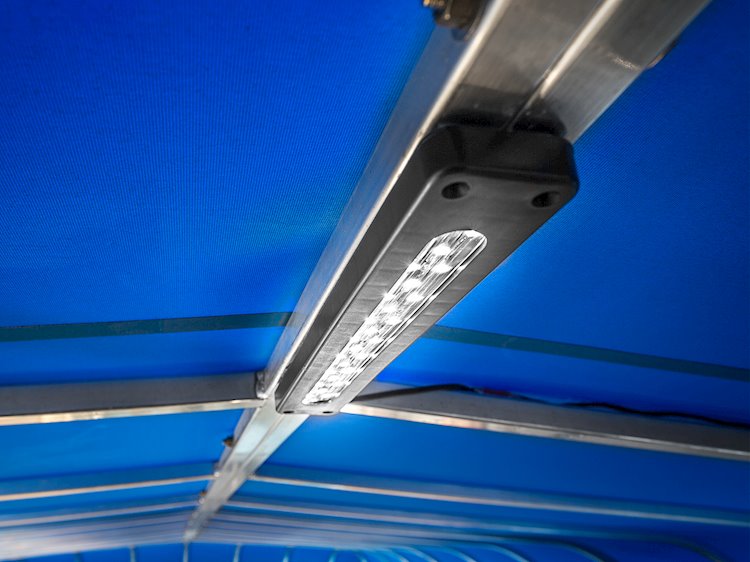
Canopy lights
Maybe it’s making sure everything is battened down during a storm. Sometimes, you have to raise or lower your boat while it’s dark. Finally, it could simply be lights to allow you to see your lift from afar. Having lights can be a lifesaver.
Install an LED light system to provide lighting for your dock and boat lift. Hint: Place a red and green light at the end of your dock, so you know what side you are approaching in the dark. Do you need a light to safely board or exit your boat? These benefits can all be integrated into an electrical system of your boat lift. You can get the power from your solar panel system. Use a wireless remote to turn the lights on and off.
Supports for a boat
Cradles and bunks for your lift support your boat on the lift safely. There a whole range of different types of hull supports you can install on your boat lift to get that perfect fit.
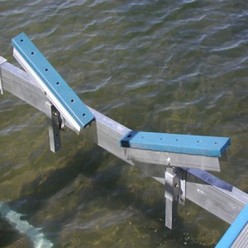
ShoreMaster Cradles
These come in several categories:
Cradles are pivoting pads that stabilize and support the hull of your boat. Today, these are seldom used. People prefer the use of bunks which distribute the weight over a large area.
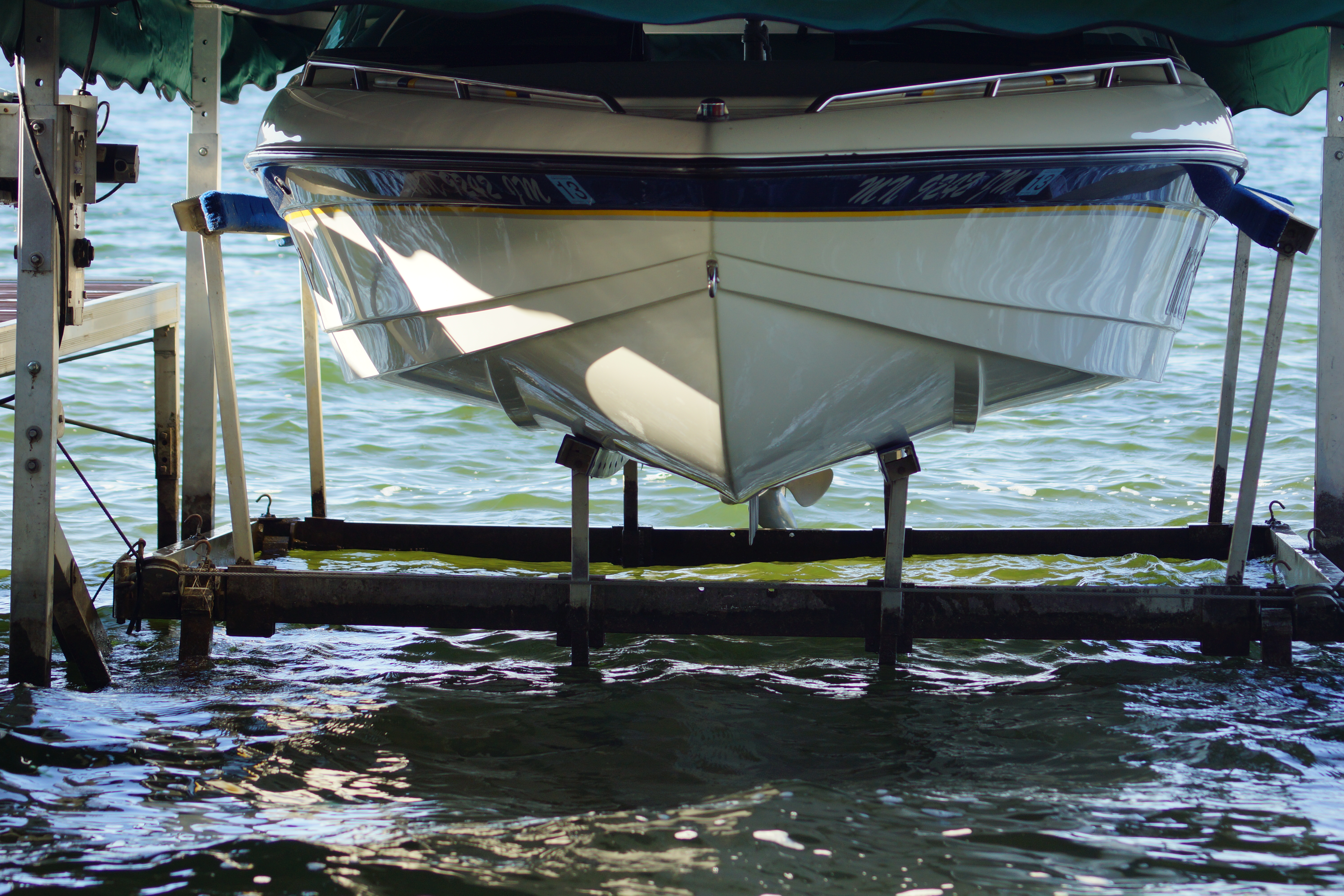
Full-length Bunks and Guide – on
Full-length bunks provide maximum support and stability. These aluminum extrusions will contour to your watercraft and are
covered in vinyl which resists the adhesion of sand and debris. They can be offset toward your pier for easier access as well.
be careful when offset
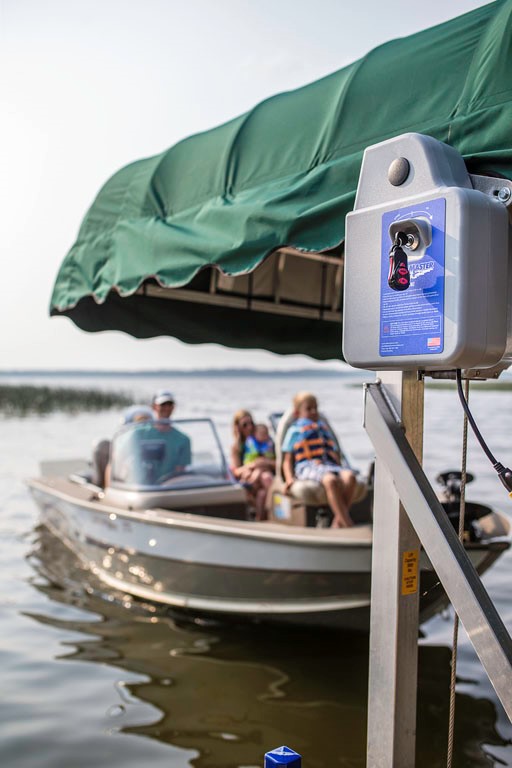
Lift Boss Motor
Lift Boss Motor
A boat lift motor is a popular accessory when you get tired of trying to raise your boat by hand. You’ll probably get one because your better half or the kids have difficulty turning the large wheel. No one has ever complained about having a motor on the lift. They only wish that they had done it earlier.
See this link for more information.
Wireless Remote
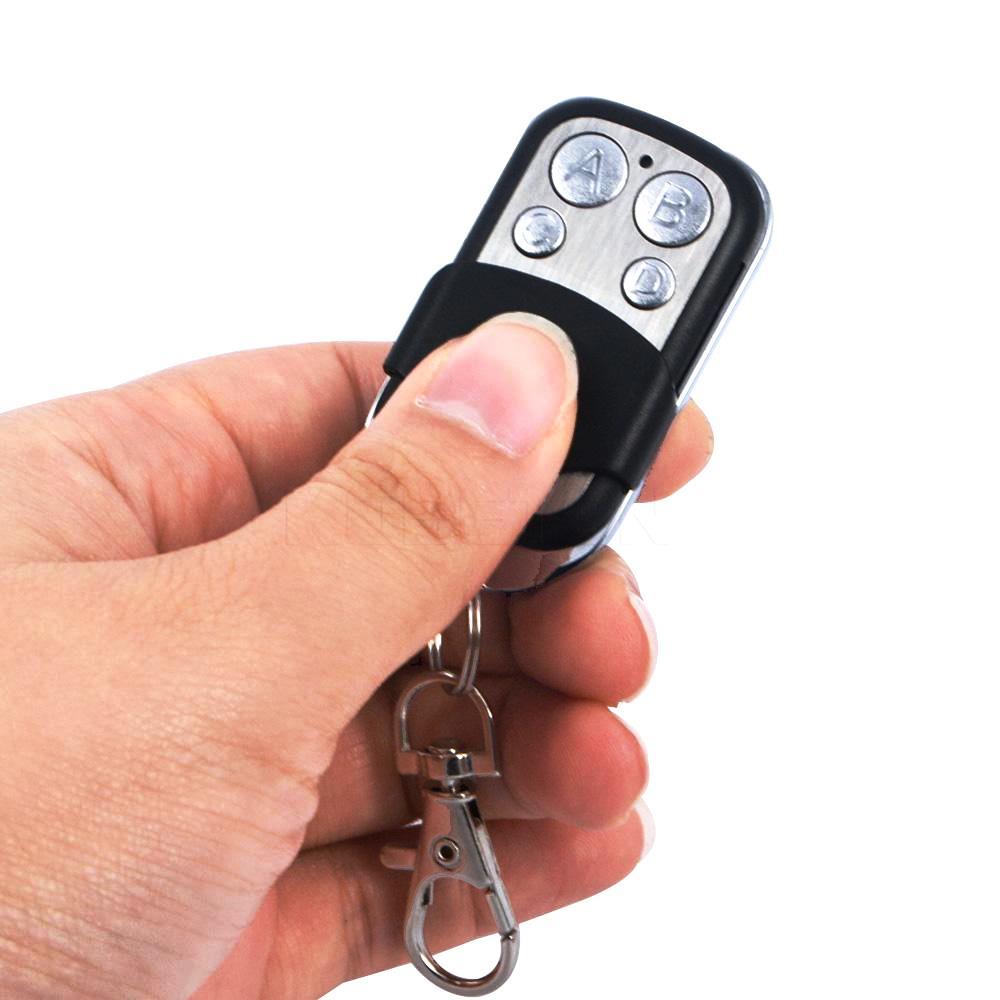
Remote Control
Once you’ve started to accumulate accessories for your pier and boat lift, you may want a more convenient way to control it all. That’s where a wireless remote comes in.
If you have an electric winch operated boat lift, you can get a wireless remote which lets you raise or lower your boat from up to 300 feet away. The same remote can additionally operate
your LED floodlight system. This means you can turn on the lights and lower your boat into the water before even setting foot on the dock.
If that’s not convenient enough, you can even put the key fob remote on your keychain, so it’s always on hand. If you can open your garage and unlock and start your car with a key fob, why not make it just as easy for your boat?
See more lift accessories at this link: Shoremaster
Call PWS for Boat Lift Accessories and Maintenance
Depending on what sort of accessories you’re interested in, such as the bunks and cradles, it’s probably a good idea to get professional help choosing and installing these accessories. PWS is a team of professionals, and we’re well-equipped to handle any maintenance you need for your boat lift in the Door County area.
Give us a call today and let’s discuss how we can make your boat lift and pier as convenient to use as possible!
PWS is located at 7325 St. Hwy 57. That’s 1 mile North of County MM (Hwy 42) and 3 miles South of Sturgeon Bay at the Idlewild Road intersection. Our staff is here year-round to assist you.



































